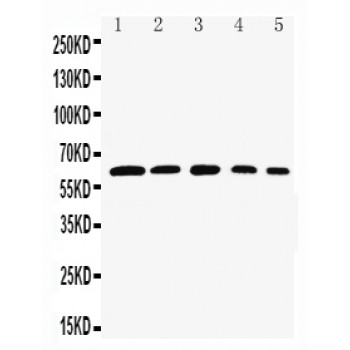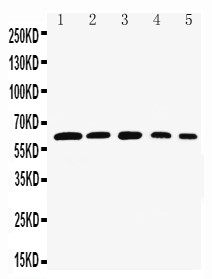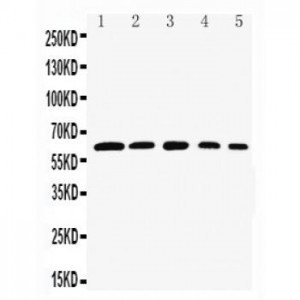More info
Overview
Long Name | Antibody Type | Antibody Isotype | Host | Species Reactivity | Validated Applications | Purification |
| v-rel reticuloendotheliosis viral oncogene homolog B | Polyclonal | IgG | Rabbit | Human, Mouse, Rat | WB | Immunogen affinity purified. |
Immunogen | ||||||
| A synthetic peptide corresponding to a sequence at the C-terminus of human Rel B(393-413aa LPFTYLPRDHDSYGVDKKRKR), identical to the related mouse sequence. | ||||||
Properties
Form | Lyophilized |
Size | 100 µg/vial |
Contents | Antibody is lyophilized with 5 mg BSA, 0.9 mg NaCl, 0.2 mg Na2HPO4, 0.05 mg Thimerosal and 0.05 mg NaN3. *carrier free antibody available upon request. |
Concentration | Reconstitute with 0.2 mL sterile dH2O (500 µg/ml final concentration). |
Storage | At -20 °C for 12 months, as supplied. Store reconstituted antibody at 2-8 °C for one month. For long-term storage, aliquot and store at -20 °C. Avoid repeated freezing and thawing. |
Additional Information Regarding the Antigen
Gene | RELB |
Protein | Transcription factor RelB |
Uniprot ID | Q01201 |
Function | NF-kappa-B is a pleiotropic transcription factor which is present in almost all cell types and is involved in many biological processed such as inflammation, immunity, differentiation, cell growth, tumorigenesis and apoptosis. NF- kappa-B is a homo- or heterodimeric complex formed by the Rel-like domain-containing proteins RELA/p65, RELB, NFKB1/p105, NFKB1/p50, REL and NFKB2/p52. The dimers bind at kappa-B sites in the DNA of their target genes and the individual dimers have distinct preferences for different kappa-B sites that they can bind with distinguishable affinity and specificity. Different dimer combinations act as transcriptional activators or repressors, respectively. NF-kappa-B is controlled by various mechanisms of post-translational modification and subcellular compartmentalization as well as by interactions with other cofactors or corepressors. NF-kappa-B complexes are held in the cytoplasm in an inactive state complexed with members of the NF- kappa-B inhibitor (I-kappa-B) family. In a conventional activation pathway, I-kappa-B is phosphorylated by I-kappa-B kinases (IKKs) in response to different activators, subsequently degraded thus liberating the active NF-kappa-B complex which translocates to the nucleus. NF-kappa-B heterodimeric RelB-p50 and RelB-p52 complexes are transcriptional activators. RELB neither associates with DNA nor with RELA/p65 or REL. Stimulates promoter activity in the presence of NFKB2/p49. As a member of the NUPR1/RELB/IER3 survival pathway, may provide pancreatic ductal adenocarcinoma with remarkable resistance to cell stress, such as starvation or gemcitabine treatment. Regulates the circadian clock by repressing the transcriptional activator activity of the CLOCK-ARNTL/BMAL1 heterodimer in a CRY1/CRY2 independent manner. Increased repression of the heterodimer is seen in the presence of NFKB2/p52. |
Tissue Specificity | |
Sub-cellular localization | Nucleus. |
Sequence Similarities | Contains 1 RHD (Rel-like) domain. |
Aliases | I REL antibody|I-Rel antibody|IREL antibody|Nuclear factor of kappa light polypeptide gene enhancer in B cells 3 antibody|relB antibody|RELB_HUMAN antibody|Reticuloendotheliosis viral oncogene homolog B antibody|Transcription factor Rel B antibody|Transcription factor RelB antibody|v rel avian reticuloendotheliosis viral oncogene homolog antibody|v rel avian reticuloendotheliosis viral oncogene homolog B antibody|v rel reticuloendotheliosis viral oncogene homolog B antibody |
Application Details
| Application | Concentration* | Species | Validated Using** |
| Western blot | 0.1-0.5μg/ml | Human, Mouse, Rat | AssaySolutio's ECL kit |
AssaySolution recommends Rabbit Chemiluminescent WB Detection Kit (AKIT001B) for Western blot. *Blocking peptide can be purchased at $65. Contact us for more information

Anti-Rel B antibody, ASA-B1619, Western blotting
Lane 1: Rat Testis Tissue Lysate
Lane 2: HELA Cell Lysate
Lane 3: NIH3T3 Cell Lysate
Lane 4: RAJI Cell Lysate
Lane 5: HEPA Cell Lysate
Lane 1: Rat Testis Tissue Lysate
Lane 2: HELA Cell Lysate
Lane 3: NIH3T3 Cell Lysate
Lane 4: RAJI Cell Lysate
Lane 5: HEPA Cell Lysate



